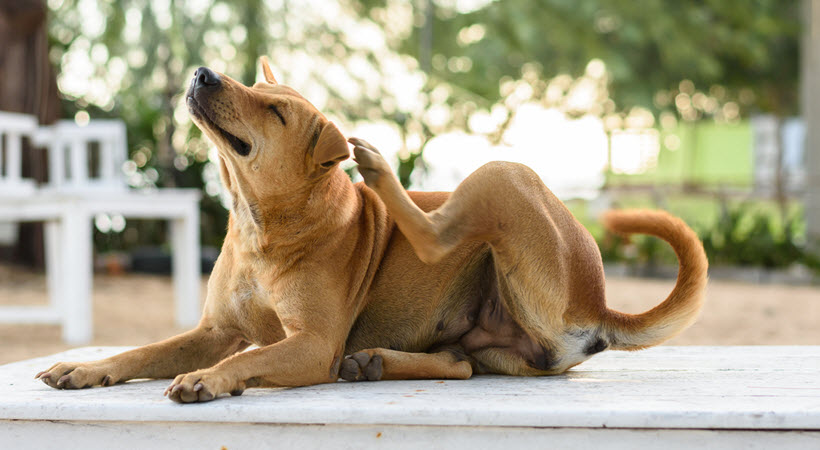Compulsive licking, biting, and scratching (CLBS) in dogs is a pretty common problem. Many dog owners struggle with it on some level. It’s important to understand your dog’s behavior so that you can help them stop.

Reasons:
There are many reasons why dogs start to lick, bite, or chew compulsively. Here are some of the most common reasons:
- Boredom or Compulsion – Some dogs will develop compulsive behaviors due to boredom or separation anxiety.
- Anxiety & Stress – An anxious dog may lick his paws raw as he tries to soothe himself
- A Medical Condition – If your dog has an underlying medical condition, like an allergy or intestinal parasite, behavioral problems can occur as a result of his discomfort.
- Inability to Communicate Desires & Misdirected Behavior – A dog may have learned that certain behaviors get him what he wants from you (attention and affection), so he continues to repeat the same thing even when it doesn’t help him feel better.
- Lack of Exercise – Dogs who don’t get enough exercise might engage in repetitive behaviors such as licking because they’re bored.
Common Dog Breeds with CLBS:
Certain breeds of dogs tend to be more prone to compulsive licking and chewing than others, including the following:
- Cavalier King Charles Spaniel
- Cocker Spaniel
- Dachshund
- French bulldog
- Golden retriever
- Long-haired Dachshunds
- Miniature poodle
- Papillon
- Pekingese Pomeranian
- Schnauzer
- Shih Tzu Siberian Husky Yorkshire terrier
When pets have compulsive licking or biting, they are trying to alleviate the stress of some kind. While some animals lick and bite in response to allergies or skin infections like staph infection in dogs, fleas, and mites, other pets lick and chew because of boredom or learned behavior. These habits can become a problem if they become obsessive or injure the pet while engaged in their behavior.
Excessive licking and chewing can be painful, and it’s often difficult to convince a dog with this behavior problem to stop. In addition to the discomfort, compulsive licking and chewing can damage your dog’s body. You may have to seek professional help if you can’t stop the behavior.
Read more: Basic Tips for Keeping Your New Puppy Healthy and Safe
Some common areas for CLBS are:
- The feet or paws. This might be due to fungi, allergies, or insect bites.
- The face and ears. This can be due to insect bites, food allergies, or contact allergies from things like grasses and pollen.
- The tail base. This area can become infected with bacteria that thrive in moist environments.
- The chest and abdomen. This might be due to fungal infections or insect bites.
Treatment:
Treatment for your dog’s compulsive scratching or chewing involves both behavioral therapy, which helps your pet associate its destructive behavior with unpleasant consequences, and usually also involves anti-anxiety medications.
Groom your pet – The best way to avoid these problems is to keep your pet well-groomed, practice preventative health care, and see your veterinarian at the first sign of discomfort. If you can’t figure out what’s causing the problem, they can help you diagnose and recommend treatment.
Keep the surroundings clean – If you live in an area where fleas are common, your veterinarian will likely prescribe a flea control medication. If your pet has allergies, he’ll need medical treatment as well as regular grooming to keep his coat healthy and smooth. Seek veterinary care if the itching is severe, accompanied by other symptoms, or doesn’t respond to home treatments.
Treat contact allergies by applying oatmeal-based shampoo weekly to your pet’s skin and hair coat. Don’t use medicated shampoos on dogs with a history of seizures (they may contain ingredients that cause seizures).
Behavior modification – This involves using positive reinforcement to encourage your pet to avoid the areas where they lick, bite, and scratch. For example, your dog may be rewarded with a treat every time they avoid the tailbone area. Then gradually, their attention is drawn away from it completely. It’s important not to punish your pet for these behaviors, or they will become anxious and anxious pets lick more as an effect of stress.
Natural supplements – Certain dog skin supplements have been shown to be effective in reducing symptoms associated with compulsive licking, biting, and scratching in dogs.
Conclusion:
In the end, it may be a process of trial and error until you achieve the results you are looking for. The key is patience and perseverance. That being said, make sure that it is a consultation with your veterinarian about which treatment method is best for your dog.
